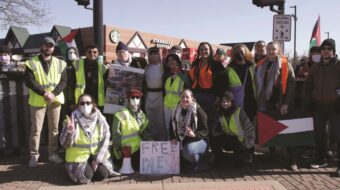
NEW YORK — Michimasa Hirata was not supposed to be speaking in Dag Hammarskjold Plaza on Aug. 9, the 62nd anniversary of the bombing of Nagasaki, Japan. Another atomic bomb survivor was to address the crowd about the atrocities that resulted from the use of atomic bombs against the largely civilian populations of Hiroshima and Nagasaki.
But in a tragic illustration of the bombs’ continuing effects, the originally scheduled speaker was diagnosed with leukemia in April and died within the following two weeks.
In his place, Hirata, a Hiroshima survivor, recalled the day when the United States dropped an atomic bomb on his city. “It was a hell, an inferno,” he reflected quietly. “On the doorway in front of my house, there were people with burns so bad it was impossible to distinguish male from female, young from old.”
Hirata was traveling with Peace Boat, a Japanese nongovernmental organization that organizes voyages across the globe to promote international solidarity and peace. In this, its 24th year of operation, a large passenger boat carrying some 900 peace activists docked in New York City to commemorate the 62nd anniversary of the bombings of Hiroshima and Nagasaki and to hold the third annual People Building Peace Concert.
The event, featuring speeches by prominent disarmament activists and performances by musical groups spanning the globe from India to Nigeria to Latin America, was sponsored by groups as diverse as the Hague Appeal for Peace, Art Refuge, United for Peace and Justice and Mayors for Peace, the latter representing 1,698 cities in 122 countries and regions.
Hundreds of people listened attentively to the message of the Peace Boat participants and the sponsoring organizations of the voyage. Peace Boat U.S. organizer Maiko Morishita explained that the event empowered citizens to realize that “we’re not powerless — it’s not up to the government to decide. [The government] discusses disarmament as if it was their own business, but it’s not. They’re discussing the future of our world, and it’s our world, and it’s going to be the world of our children.”
In that spirit, the crowd became a symbol of the international community of peace the boat was designed to promote. Japanese participants danced with New Yorkers to Nigerian jazz, all in a reaffirming hope that the world would one day be free of the threat of nuclear arms.
Betty Reardon, founder of the International Institute on Peace Education, explained the spirit of the event by noting that Nagasaki Day is “a day of shame, a day of sorrow,” because of the United States’ past use of atomic weaponry, but also “a day of hope, a day of possibility, of commitment, of courage,” because it challenges the international community to unite in opposition to an increasingly violent U.S. foreign policy.
More than six decades after the U.S. atomic bombing of Hiroshima and Nagasaki, which killed over 220,000 people, the threat that nuclear arms will be used again is still real. Michimasa Hirata expressed his hope that today’s youth — the last generation that will hear the call for disarmament directly from Hiroshima and Nagasaki atomic bomb survivors — will take direct and mass action to oppose the use and stockpiling of nuclear arms.
In light of the U.S. failure to ratify the Comprehensive Test Ban Treaty or to take any significant action to cut the global stockpiling of nuclear weapons, organizers said a tremendous amount of work remains to be done. However, the Peace Boat’s visit to New York to commemorate Nagasaki Day expressed the hopes of people the world over for peace. Until a nuclear-free world is achieved, the Peace Boat has vowed to continue to circle the globe, working to realize that goal.
Mary Slosson (maryslosson @gmail.com) is an intern at the People’s Weekly World.











Comments